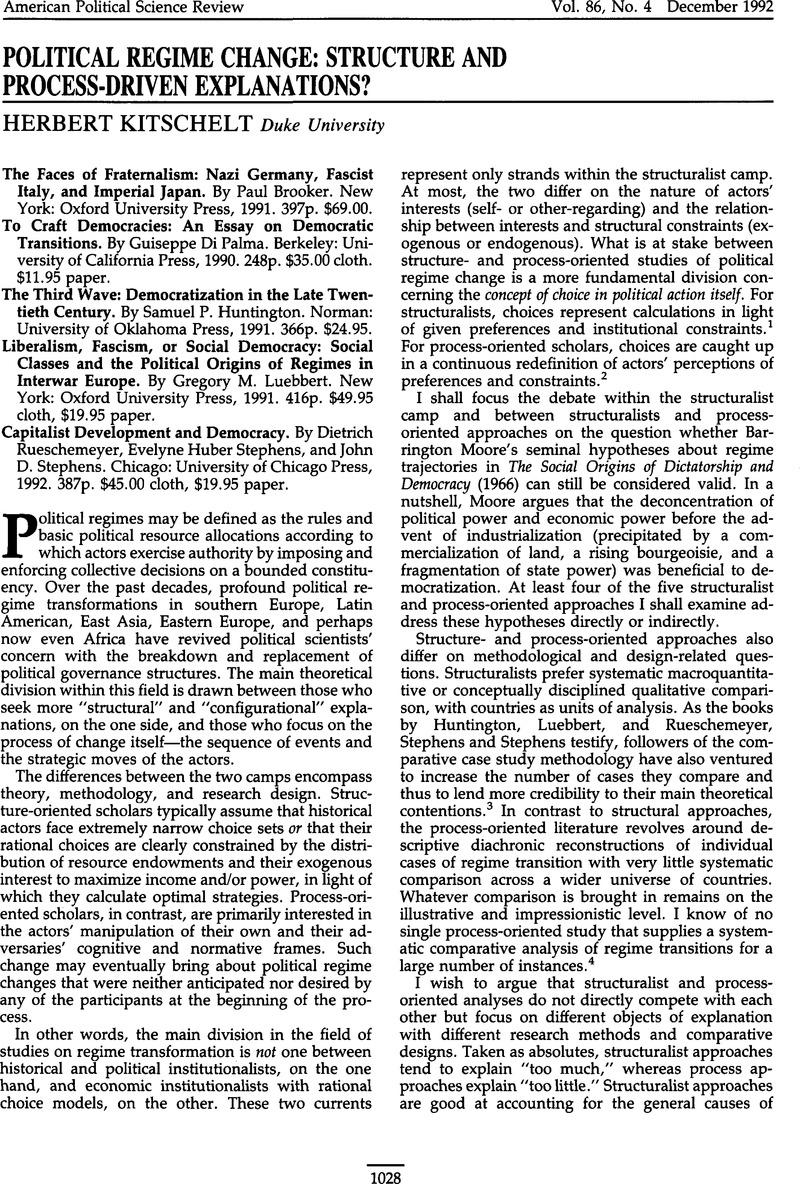Article contents
Political Regime Change: Structure and Process-Driven Explanations?
Published online by Cambridge University Press: 02 September 2013
Abstract

- Type
- Book Reviews
- Information
- Copyright
- Copyright © American Political Science Association 1992
References
Notes
1. For examples, Rogowski's, RonaldCommerce and Coalitions (1989)Google Scholar is an avowedly rational-choice-based account; yet it considers itself to provide a generalization of Gerschenkron's and Moore's comparative-historical class-based structuralism. Conversely, Skocpol's, ThedaStates and Revolutions (1979)CrossRefGoogle Scholar is explicitly based on structuralist premises yet implicitly assumes rational actors who maximize wealth or power and are not driven by more illusive ideas.
2. Sometimes contributors to studies of regime transformation misunderstand their own accomplishments. In this sense, Przeworski, Adam in Democracy and the Market (1991)CrossRefGoogle Scholar wishes to offer a rational-choice-based explanation of regime change yet really falls back onto a historical institutionalism plus a process-oriented reconstruction of actors' changing cognitive frames.
3. Rogowski's book (see n. 1) is the other major examples of this more comprehensive comparative approach.
4. Probably closest to the systematic and encompassing comparison of transition processes I am looking for are Karl's, Terry articles, especially “Dilemmas of Democratization in Latin America” (Comparative Politics [1990])Google Scholar and (with Schmitter, Philippe) “Modes of Transition in Latin America, Southern and Eastern Europe” (International Social Science Journal, May 1991)Google Scholar. In these and other examples, however, the conceptualization of the main independent variable, modes of regime transition, is not sufficiently refined.
5. I am setting aside here the question whether it is still adequate in light of recent historical research to refer to the rise of Scandinavian social democracy as a “red-green” coalition of workers and farmers against the bourgeoisie. As Swenson's research makes clear, there emerged, if anything, a sectoral coalition in which parts of Labor and business cooperated with agriculture against Labor and business in other sectors. See Swenson's, Peter “Bringing Capital Back In” (World Politics 43[1991])Google Scholar.
6. To explore the influence of religion, see especially the broad comparative neo-Weberian account in Hall's, JohnPowers and Liberties (1985)Google Scholar.
7. I have added up rankings of the countries on each of Huntington's four criteria and singled out countries with the four lowest rankings. At the top of democratic promise are Spain, Greece, Portugal, Turkey, Uruguay, Chile, Ecuador, Czechoslovakia, Hungary, Bolivia, Brazil, Peru, Philippines, and South Korea.
8. According to Huntington, even formal democracies in predominantly Confucian countries are characterized by the absence of government turnover (p. 304).
- 60
- Cited by



Comments
No Comments have been published for this article.